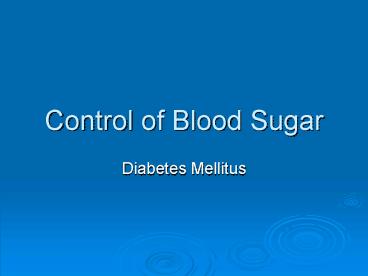Control of Blood Sugar - PowerPoint PPT Presentation
1 / 21
Title:
Control of Blood Sugar
Description:
In response, the pancreas releases glucagon into the blood. ... Glucagon: Stimulates liver cells to break down glycogen and release the glucose into the blood. ... – PowerPoint PPT presentation
Number of Views:548
Avg rating:3.0/5.0
Title: Control of Blood Sugar
1
Control of Blood Sugar
- Diabetes Mellitus
2
Maintaining Glucose Homeostasis
- Goal is to maintain blood sugar levels between 70
and 110 mg/dL - Two hormones play a role in maintaining glucose
homeostasis - Insulin
- Glucagon
- Both are pancreatic hormones
- See page 117
3
Lowering Blood Glucose Levels
- Blood glucose levels rise due to eating a
carbohydrate containing meal - In response, the pancreas releases insulin into
the blood. - Beta cells of the pancreas release insulin
4
Lowering Blood Glucose Levels
- Insulin
- Binds to insulin receptors on cells.
- Cells allow glucose to enter
- Stimulates liver and muscle cells to store
glucose as glycogen - Stimulates excess glucose to be converted into
fat. - As a result, blood glucose levels drop.
5
Raising Blood Glucose Levels
- Blood glucose levels drop as cells use glucose.
- In response, the pancreas releases glucagon into
the blood. - Alpha cells of the pancreas release glucagon
6
Raising Blood Glucose Levels
- Glucagon
- Stimulates liver cells to break down glycogen and
release the glucose into the blood. - As a result blood glucose levels rise.
7
Diabetes Mellitus
- Diabetes mellitus refers to a group of metabolic
disorders in which the body is unable to regulate
high blood glucose levels.
8
Diabetes Mellitus
- Two common forms
- Type 1 diabetes
- Other names
- Juvenile diabetes
- Insulin dependent diabetes mellitus (IDDM)
- Type 2 diabetes
- Other names
- Adult onset diabetes
- Noninsulin dependent diabetes mellitus (NIDDM)
9
Incidence of Diabetes
- Type 1 Diabetes
- 5-10 of diabetics
- Onset is generally before age 20
- Average age of onset 12
- Type 2 Diabetes
- 90-95 of diabetics
- Onset is generally between ages 10-19 or after
age 40
10
Type 1 Diabetes
- Possible causes
- Autoimmune disorder
- Genetic component
- Immune system destroys beta cells of pancreas
- May also be caused by a viral infection that
damages the pancreas
11
Type 1 Diabetes
- Pancreas is unable to make/secrete insulin.
- Glucose cannot enter cells ? hunger
- Blood glucose levels rise
- Glucose spills into the urine
- Water moves into blood
- Frequent need to urinate
- Thirsty
12
Type 1 Diabetes
- Cells use fats and proteins as an energy source,
results in - Weight loss ? hunger
- Ketones produced (due to overuse of fats for
energy) ? potential for diabetic acidosis
13
Type 1 Diabetes
- Diabetic acidosis (ketosis)
- Ketones in breath
- Ketones in blood and urine
- ? can lead to diabetic coma
14
Type 1 Diabetes
- Treatment
- Insulin shots or pump
- Highly regulate intake of carbohydrates
- Consistent pattern of moderate carbohydrate
intake to minimize fluctuations in blood glucose - Closely monitor blood glucose levels
15
Type 2 Diabetes
- Associated with obesity
- As gain weight, cells make fewer insulin
receptors - Insulin doesnt bind as well to receptors made
- Genetic component
- More common as age
16
Type 2 Diabetes
- Fewer insulin receptors on cells
- Less insulin binds to cells
- Glucose enters cells SLOWLY
- Blood glucose levels remain elevated
- Glucose spills into the urine
- Water moves into blood
- Frequent need to urinate
- Thirsty
17
Type 2 Diabetes
- Glucose enters cells slowly
- No need to use proteins or fats for energy
- Hungry
- Eat more ? gain weight
- Exacerbates the problem
18
Type 2 Diabetes
- Pancreas continues to make insulin
- Often in large amounts to compensate for the
insulin resistance of cells - May get to point where pancreas cannot keep up
with the bodys needs and insulin is required.
19
Type 2 Diabetes
- Recommendations
- Lose weight
- Even moderate weight loss can help
- Exercise
- Increases number of insulin receptors
- Improves binding of insulin to the receptors
- Helps with weight loss
20
Chronic Complications of Diabetes
- Regular high blood glucose levels result in
- Cells making sugar alcohols
- Glucose binds to proteins on cells, damages cells
- Results in
- Damage to blood vessels and nerves
- Slowed healing
- Unaware of wounds? amputation
- Kidney damage ? kidney failure
- Damage to cells of eyes ? blindness
21
Chronic Complications of Diabetes
- Other
- Increased risk of
- Coronary heart disease
- Elevated blood lipid levels
- Hypertension

